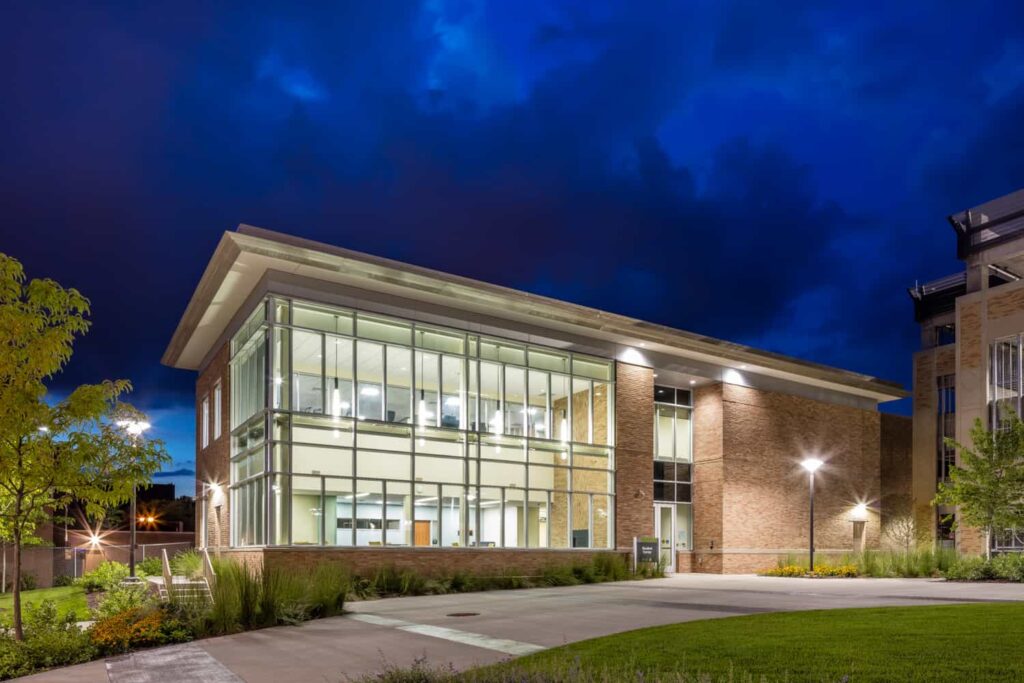While summer vacation takes most of our attention away from the school violence dominated the news cycle in the spring, the reality has not changed for students, staff, and administrators. The issue is especially acute at colleges and universities, where multiple buildings, open spaces, pedestrian walkways, and skyway systems challenge even the best campus police. With all of those physical attributes, providing necessary safety and security is a complex challenge. Architects and designers confront these challenges with comprehensive approaches to safety and security.
Understanding the role that design of the physical environment plays in creating a safe learning environment as well as a welcoming educational experience is the key to unlocking balance. Once colleges and universities have established their critical threats and risks, safety strategies can be used to mitigate those risks. While college safety officials typically incorporate active safety strategies and emergency response strategies, designers can delve into passive safety strategies that relate to the design of the buildings, site, or systems.
Active Safety Strategies
There are many aspects to be considered when implementing a total campus security plan. All colleges and universities use some form of active security strategies such as surveillance, access control, emergency call boxes, and safety patrol. Even though these types of strategies are handled by campus safety officials, designers can assist in making these strategies more effective.
By specifying the proper type of surveillance equipment and ensuring proper placement for the interior and exterior of a building, blind spots can be eliminated. For effective surveillance, a common myth must be busted – the more cameras the merrier. It is not encouraged to spend money on extra cameras, when a good layout and design will do the trick.
Access control is another common design challenge since many campuses are considered public facilities, and as such need to be kept open to the public. To complicate matters even further, many campuses have robust skyway and tunnel networks that need to stay open. Careful thought and consideration should be given to the types of doors, hardware, technology, and locking functions.
While research finds that emergency call boxes are rarely used, their presence can be a comfort to students and parents. More popular at urban campuses intermingled within the city, these call boxes provide a way for anyone on campus to find help. Designers can help locate these call boxes in appropriate places around campus so that they become an effective crisis management solution.
Passive Safety Strategies
Lighting: It is important to have intentional conversations with your design team about lighting. Exterior lighting can enhance safety and security if it is designed properly, but if done incorrectly lighting can make a space less safe. Poorly designed lighting can actually be helpful to criminals by producing shadows that disguise them. Also, being temporarily blinded by a glaring light source makes you an easier target for criminals, and limits your ability to see their face.
In lieu of more and brighter lights, practical lighting that directs light downward in appropriate places will both help with security and minimize light pollution. Fully shielded light fixtures that shine the light downward will not create glare and contrast. The goal is to provide effective lighting that actually helps people be safe and not just feel safe.
Visibility: Clear sightlines can improve safety on campus, both inside a building and outside. Metropolitan State University, located in Saint Paul, is considered an urban campus. Enhancing visibility was key in the design of their new Student Center. During the planning process, the location of the security desk was thoughtfully placed to ensure clear sightlines to both the campus and public entrances and into key public areas such as their café. The location of the security desk is immediately visible to all who enter the building and is intended to promote a sense of security.
To improve sightlines on campus grounds, make sure views to the public pathways are unobstructed and properly lit so it’s easy to view the outside from interior spaces at night. While landscaping is always a nice touch, it can also conceal threats. Ground plantings should be trimmed low and kept away from pathways and building entrances. Tree canopies should be kept above sightlines and not block security cameras.
Wayfinding: When visiting a new place for the first time, the human mind begins to make a mental map. It begins to create a visual account of the spatial connections and distances between locations. Each time the same place is visited, the mental map improves and the space becomes more familiar. Buildings that are designed with a simple and understandable flow tend to be easier to navigate and remember. Other design methods to employ for ease of wayfinding include providing common color schemes, graphics, and floor or ceiling patterns. These elements provide necessary clues about a place, whether in panic mode or not.
When designing a building for wayfinding and safety, it is valuable to note that people are more likely to take the same route they entered rather than the shortest or most direct route to exit. Having familiarity with an exit is more important to people and will cause them less stress than taking an unknown path. Work with your designer to create circulation spaces with minimal angles and corners to aid wayfinding in emergency situations. Clear visibility to escape routes allows quick decision making for those exiting in a hurry. In addition, on campus grounds, there may be a preference for students to walk a longer route along busier pathways if it makes them feel safer.
The architectural community seeks new and innovative solutions address the safety concerns hammering our nation’s educational system. Violence in our schools needs to stop and architects can help.
Part III: Planning for Emergencies
The second of a three-part series looking at safety and security on college and university campuses, the third examines strategies for emergencies and how design can help organizations better control the outcomes from adverse events.








